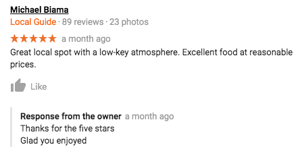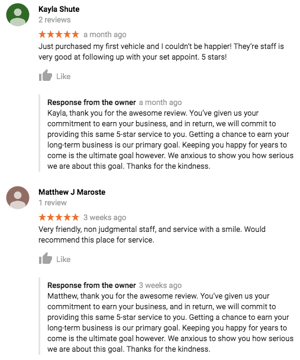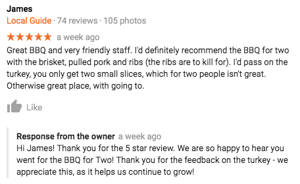-
Products
TechnologyManaged Services
- Resources
- Pricing
- Company
There are eight different ways to respond to online reviews and the team at Widewail has ranked them from worst to best. Read our post today!

From day one, our mission has been to perfect how to respond to online reviews. The Widewail team has spent countless hours scouring the web to learn how businesses across the world engage and interact with their customers. From our research, we have determined that there are eight different response categories. Below they are listed from worst to best - where do your responses fall?
Coming in dead last: no response at all.
Reviews stack up without acknowledgment. Hundreds of customers go unthanked. Rude language and misinformation remain online. All in all, ignoring reviews makes it look like the company doesn’t care about its guests, or its reputation.
The positive reviews get the attention they deserve, but negatives go overlooked.
This might be the worst message to send potential customers: that guests without complaints will be treated with kindness but those looking for help will be ignored.
Even beyond customer service, negative reviews provide valuable information to businesses about how they can improve. The only thing worse than ignoring negatives is responding to them in anger. No matter what the review says, answering in an aggressive tone makes the company seem petty and will invite a very public customer service fire.
One step above ignoring reviews is responding with as little effort as possible. Each positive review receives the same “Thank you,” while unhappy customers are provided a general email address where they can send their feedback. At least there is an answer, but no one believes that anyone from the company is actually concerned about resolving their patrons’ problems, and this is not part of an effective online review management strategy.

Even a response that contains great content can be ruined with grammar issues, incorrect spelling, and awkward prose. Mistakes like these, especially ones that would be fixed with a simple proofread, paint the company in a very unprofessional light.
If the business doesn’t care about the details when it comes to communicating with their clients, will their care about the details when it comes to their service?
It’s obvious that these responses are copied and pasted from a template, or otherwise written by a machine. While detached responses might seem like the most professional option, they may further upset unhappy customers.
These dissatisfied guests are looking for answers and they want to speak to a real human, not an automated message.
Future customers might be turned off as well, believing that the service they can expect in person will be as cold as the interactions they viewed online.

We know that businesses are enthusiastic about their customers, but it’s possible to go overboard when it comes to answering online review.
All-caps paragraphs running longer than the review itself, multiple thank yous, excessive emojis and exclamation points all will be overwhelming to the reviewer. Customers should be treated with respect, not pandered to.
This response meets all the basic requirements, but it’s missing a huge opportunity: SEO keywords.
Terms like the dealership name, car makes and models, and services offered help increase the company’s rank in local GMB searches. While not necessarily bad in terms of customer services, these responses aren’t doing anything for SEO optimization.

Finally, the best option: a response written by experts.
Easy to read, professional with a personal touch, packed full of SEO terms without being clunky. This is the response which will thank current customers properly, boost the company site’s ranking with the GMB, and encourage potential clients to give the business a chance. We also know what not to do.
Best of all, it requires no additional effort from the team assisting guests in person. They can focus on their job, knowing that their clients will be well taken care of even after they leave the store.
Hey, Jane here. Thanks for reading. Next, I recommend Widewail's review response examples guide. The response team and I have responded to 270,000 reviews since Widewail's beginning. In that time we've developed, practiced, and perfected the techniques explained in this guide. Learn review response from 19 real-world examples, covering how you can handle 19 unique response scenarios. Download the Guide 👇
I’m a New Jersey native who joined the Widewail team during my brief stint in Burlington. Now living in Jersey City, I currently serve as the Response Team Lead and Content Specialist. My background is in writing and my work has been published by Thrillist, Reductress, McSweeneys, The Rumpus, and more. I occasionally update my own blog No Meat, Some Potatoes, and in my free time I hang out with my dog Jake.
Bite-sized, to-the-point, trend-driven local marketing stories and tactics.
Automated Review Generation
Video Testimonial Generation

Maintain Accurate Listings

Private Surveys
Review Response Managed Services
Social Media Engagement Services
©Widewail 2026.
U3GM Blog Post Comments